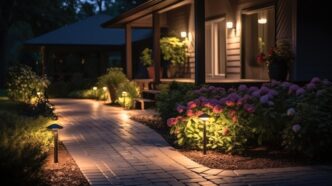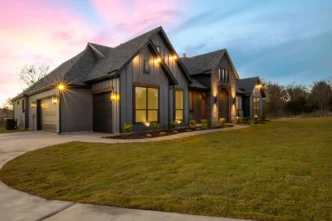Table of Contents: Beam Angle Basics
- What Is a Beam Angle?
- The Importance of Beam Spread in Landscape Lighting
- Types of Beam Angles
- Wide Beam (70° to 130°)
- Choosing the Right LED Angles for Your Space
- LED Angles vs. Fixture Placement
- Best Practices for LED Angles
- Bringing It All to Light with Proper Beam Angles
When it comes to landscape lighting, the right beam angle plays a crucial role in transforming your space.
Whether you’re illuminating a garden, highlighting architectural features, or lighting up a pathway, understanding the various LED angles allows you to create the perfect ambiance, enhance safety, and showcase the beauty of your home’s exterior.
Let’s break down the types of beam angles and how they can elevate your landscape lighting game.
What Is a Beam Angle?
Beam angle, also known as beam spread, is the angle at which light is emitted from a fixture. It determines how wide or narrow the light is projected from the source. The angle is measured in degrees, and a fixture’s beam spread affects the area illuminated by the light.
For instance, a narrow beam spread will focus light on a specific area, creating intense illumination, while a wider beam spread will diffuse light over a larger area, resulting in a softer and more even illumination. Understanding beam spread is essential for selecting the right light fixture to create the desired effect in your outdoor space.
The Importance of Beam Spread in Landscape Lighting
Beam spread is not just a technical consideration; it is a vital design element that dictates how light interacts with outdoor spaces.
The right beam spread can:
- Highlight Focal Points: Draw attention to statues, trees, or architectural details.
- Provide Functional Lighting: Illuminate paths, steps, or driveways for safety and accessibility.
- Create Ambiance: Set the mood with soft or dramatic lighting to enhance your outdoor experience.
- Enhance Safety: Ensure even illumination of walkways and outdoor living areas to prevent accidents.
On the other hand, incorrect beam spread can lead to overlighting, underlighting, or unbalanced light distribution, detracting from the aesthetic appeal and functionality of your landscape.
Types of Beam Angles
Beam spreads come in a variety of angles, typically ranging from very narrow to very wide. Here’s a breakdown of the most common categories.
Very Narrow Spotlights (10° to 18°)
Very narrow spotlights are often used to create dramatic lighting effects or emphasize architectural details such as columns, sculptures, or tall trees. Very narrow spotlights have a very tight, focused beam and are ideal for highlighting specific objects or areas.
Very narrow spotlights are useful for:
- Accent Lighting for Statues or Sculptures: This type of lighting draws attention to intricate details, creating a stunning focal point in your landscape.
- Highlighting a Flagpole or Fountain: By focusing light on these features, they become visually striking even after dark, enhancing the overall aesthetic of your outdoor space.
- Illuminating the Crown of a Tall Tree: This application allows the height and beauty of tall trees to be appreciated from a distance, adding drama and interest to your garden.
Narrow Spotlights (18° to 46°)
Slightly wider than very narrow spotlights, narrow spotlights are useful for focused task lighting or accent lighting. They still provide a targeted beam but cover a slightly larger area.
Narrow spotlights work well for:
- Lighting Up Smaller Trees or Plants: These fixtures provide just enough illumination to highlight smaller foliage without overpowering the natural beauty of your garden.
- Emphasizing Garden Art: By shining light on sculptures or decorative elements, narrow spotlights can showcase your personal style and creativity in outdoor design.
- Pathway Lighting for Focused Areas: These lights guide visitors safely along designated paths while adding a welcoming touch to your landscape.
Medium Beam (46° to 70°)
A medium beam is versatile, offering a balance between narrow and wide illumination. It’s often used for general landscape lighting, as it provides both enough focus and area coverage.
Medium beam fixtures are excellent for:
- Illuminating Wide Garden Beds, Shrubs, or Low Hedges: Medium beams create a soft glow that enhances the depth and dimension of your garden, making it more visually appealing.
- Lighting Paths or Walkways: They provide enough light for safe navigation, ensuring that pathways are clearly visible while maintaining an inviting ambiance.
- Highlighting Larger Plants or Landscape Features: By casting an even wash of light, medium beams allow larger elements of your landscape to be appreciated from a distance, creating a cohesive outdoor environment.
Wide Beam (70° to 130°)
Wide beam lights spread light over a broad area and are ideal for illuminating large surfaces or spaces. These lights are softer and more diffuse, making them ideal for general illumination rather than focusing on specific details.
Wide beam lights are particularly effective for:
- Wall Washing: Wall wash fixtures softly illuminate the side of a building or fence, creating a welcoming atmosphere that enhances your property’s exterior.
- Lighting Patios or Decks: Wide beams provide ample light for outdoor gatherings and activities, ensuring that these spaces are functional and enjoyable after sunset.
- Illuminating Large Garden Areas: Wide beam lights ensure that expansive spaces are evenly lit, making your entire garden inviting and visually appealing.
Very Wide Beam (131° and above)
At the far end of the beam angle spectrum, very wide beam spreads are designed to illuminate expansive areas with a gentle, even light. This type of beam angle creates an ambient effect for outdoor living spaces where you want a soft and welcoming glow.
Very wide beam fixtures are perfect for:
- Ambient Lighting for Outdoor Seating Areas: These fixtures create a cozy and inviting space, making it ideal for relaxation and socializing during evenings.
- Illuminating Driveways or Wide Open Spaces: Very wide beam fixtures ensure safety and visibility in these areas while maintaining an unobtrusive presence that enhances the overall environment.
- Flood Lighting for General Security: Very wide beams provide a broad wash of light that enhances safety in darker areas, deterring unwanted activity while making your property feel secure.
Choosing the Right LED Angles for Your Space
Selecting the right beam spread depends on the purpose of the lighting, the size of the area being illuminated, and the effect you want to achieve.
Here are a few factors to consider when choosing the appropriate beam angle:
- Purpose of Lighting: Different landscape lighting purposes require different beam spreads. For instance, accent lighting that highlights architectural features use narrow or very narrow beams. Task lighting for walkways will typically use medium beam angles, while ambient lighting for decks, patios, or driveways is best with wide or very wide beams.
- Distance from the Object or Surface: The distance between the light fixture and the object or surface you’re illuminating plays a key role in choosing the beam angle. A narrow beam works well for lighting distant objects, such as the top of a tree, because the light remains concentrated. But if the fixture is close to the object, a wider beam spread is often better to ensure the light covers the entire area.
- Size of the Area: Consider the size of the area you need to illuminate. A larger area will require a wider beam spread to cover more ground, while a smaller area can be illuminated with a narrower beam.
- Desired Effect: The mood and ambiance you want to create also influence your beam spread choice. If you want to create a cozy, intimate space, choose a narrow beam that focuses on specific areas, such as a sitting area or garden feature. For a more open, welcoming atmosphere, use wide beams to fill the space with soft light.
LED Angles vs. Fixture Placement
In addition to the beam angle, the placement of the light fixture is crucial to achieving the right look. For example, placing a narrow-beam spotlight close to an object will create a small, intense pool of light, while moving the same fixture further away will produce a larger, softer effect.
Here are some fixture placement tips:
- Spotlights: Spotlights are typically placed a few feet away from the object being highlighted to create a defined focus.
- Flood Lights: Flood lights with wide beam spreads are often mounted higher or further away to cover larger areas.
- Spacing: Experimenting with fixture height and distance will allow you to control the size and intensity of the light beam.
Best Practices for LED Angles
LED lights offer more control over beam angles, making it easier to create the exact lighting effect you want. Their flexibility allows you to choose from narrow spotlights to wide washes, helping you highlight key features or provide ambient lighting where needed.
To achieve a well-balanced and visually pleasing outdoor lighting design, consider the following tips:
- Layer Your Lighting: Combine narrow and wide beam angles to create depth and dimension in your landscape. A mix of focused spotlights and wider floodlights ensures both functional lighting and aesthetic appeal.
- Avoid Glare: Position LED fixtures carefully to prevent harsh, direct light that could be uncomfortable or distracting. LEDs give you more options to adjust light intensity and beam width, helping you achieve glare-free illumination.
- Focus on Key Features: Use narrow LED beams to highlight specific trees, architectural elements, or garden features. Complement these with wider beams to softly illuminate the surrounding areas for a balanced look.
- Test the Effect Before Installation: Before making anything permanent, take time to test different LED angles and fixture placements. Use temporary setups to see how the lighting interacts with your space at night. This allows you to tweak and perfect your design without committing too early.
Bringing It All to Light with Proper Beam Angles
Understanding beam angles is a vital part of creating a well-designed outdoor lighting system. Whether you’re looking to highlight specific landscape features or provide general illumination, choosing the right beam angle ensures your outdoor spaces are functional and look fantastic.
By considering the purpose, distance, area size, and desired effect, you can achieve the perfect lighting solution tailored to your unique outdoor environment.
Join our Insider list and check out the different landscape lighting options that we have to offer.






